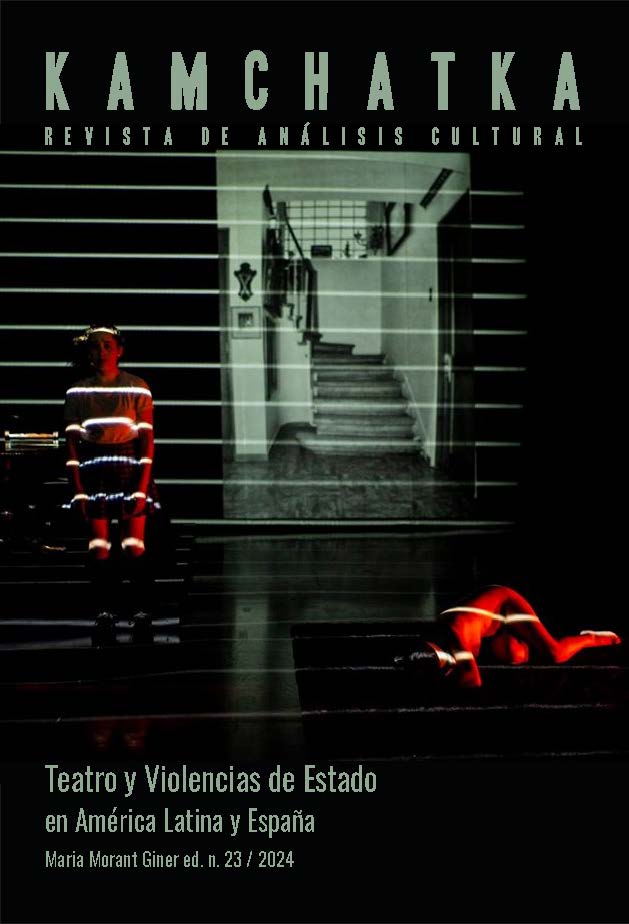Write, Heal, Cohabit: Creer en las fieras by Nastassja Martin
DOI:
https://doi.org/10.7203/KAM.23.27788Keywords:
Nastassja Martin, Writing, Body, Feral, Perspectivism, community. Abstract
Abstract
This article explores Nastassja Martin’s work, Creer en las fieras (2021), in which the French anthropologist narrates her attack by a bear in the Kamchatka mountains and then her process of physical, as well as ontological, reconstruction. We analyse three thematic dimensions present in the text: first, the writing from and about the body as a way of healing; second, the vanishing lines that project a corpo politics; and third, the cohabitation with the feral from a corporal perspectivism. In this way, the story proposes the bodily device as a metaphor for the feral in pursuit of a community with the cyclical unity of the living. As a research outcome, it’s worth asking if the text would not be part of a global literature that, within posthumanist notions, provide a novel perspective on the links between species as a fluid cohabitation of the living condition through an “emancipation story”.
 Downloads
Downloads
 References
References
Agamben, Giorgio (2007). Lo abierto. Buenos Aires: Adriana Hidalgo.
Bloch-Lainé, Virginie. “‘Croire aux fauves, la leçon d’un instant de survie”. Libération (04 décembre 2019).
Bouchereau, Marie. “Croire aux fauves de Nastassja Martin : l’exigence de ‘comprendre plus loin’”. Elfe XX-XXI 11 (2022).
Boutinet, Fanny y Cazalet-Boudigues, Alix. “L’écriture comme suture dans Croire aux fauves de Nastassja Martin”. Les chantiers de la création 14 (2022).
Castillo, Alejandra (2022). “La Corpo política y su movimiento reticular”. Asparkia: Investigación feminista 40 (2022): 39-52.
Chatelet, Caroline. “Croire aux fauves, une renaissance au plateau”. Sceneweb.fr (18 octobre 2023).
Coccia, Emanuele (2021). Metamorfosis. La fascinante continuidad de la vida. Madrid: Siruela.
Cuneo, Bruno. “La pluma del etnógrafo”. Revista Santiago (09 de mayo de 2023).
Deleuze, Gilles et Félix Guattari (1972). L’Anti-Œdipe. Capitalisme et schizophrénie. Paris: Minuit.
Deleuze, Gilles et Félix Guattari. Mille plateaux. Capitalisme et schizophrénie. Paris: Minuit.
Foucault, Michel (1987). El orden del discurso. Barcelona: Tusquets Editores.
Fraïssé, Marie-Hélène. “‘Croire aux fauves de Natassja Martin : l’étreinte de l’ours”. Le Monde (07 novembre 2019).
Geertz, Clifford (1993). La interpretación de las culturas. Barcelona: Gedisa.
Lajoux, Jean-Dominique (1996). L’homme et l’ours. Grenoble : Glénat.
Larios, Shaday (2022). “Creer en las fieras, creer en los objetos”. Post(s) 8 (2022).
Leblanc, Virginie. “Rêver, dit-elle. À propos de Croire aux fauves, de Natassja Martin”. La Cause du Désir 104 (2020).
Leca, Béatrice. “‘Croire aux fauves’ de Natassja Martin”. Samedi Fiction, France Culture (2022).
Lévi-Strauss, Claude (1955). Tristes tropiques. Paris : Plon.
Lévi-Strauss, Claude (1958). Anthropologie structurale. Paris : Plon.
Lévi-Strauss, Claude (1962). La pensée sauvage. Paris : Plon.
Marion, Rémy (2018). L’ours : L’autre de l’homme. Arles/Paris : Actes Sud.
Martin, Nastassja (2016). Les âmes sauvages. Face à l’Occident, la résistance d’un peuple d’Alaska. Paris: La Découverte.
Martin, Nastassja. “Vivre plus loin”. Terrain 66 (2016).
Martin, Nastassja (2021). Creer en las fieras. Madrid: Errata Naturae.
Martin, Nastassja (2022). À l’est des rêves. Réponses Even aux crises systémiques. Paris : La Découverte.
Morizot, Baptiste (2016). Les diplomates. Cohabiter avec les loups sur une autre carte du vivant. Marseille : Wildproject.
Negri, Antonio (2007). “El monstruo político. Vida desnuda y potencia”. Giorgi Gabriel y Rodríguez Fermín (comps.). Ensayos sobre biopolítica. Excesos de vida. Buenos Aires: Paidós: 93-139.
Pastoureau, Michel (2007). L’ours. Histoire d’un roi déchu. Paris : Seuil.
Sarduy, Severo (1969). Escrito sobre un cuerpo. Buenos Aires: Editorial Sudamericana.
Segarra, Marta (2022). Humanimales: Abrir las fronteras de lo humano. Barcelona: Galaxia Gutenberg.
Truong, Nicolas. “Le ‘vivant’, un concept qui gagne en popularité dans la philosophie el les combats écologiques”. Le Monde (22 septembre 2021).
Ume Théâtre (2023). Croire aux fauves.
Viveiros de Castro, Eduardo (2010). Metafísicas caníbales. Líneas de antropología postestructuralista. Buenos Aires: Katz.
Zanco (2023). Miedka.
Downloads
Published
How to Cite
-
Abstract109
-
Artículo PDF (Español)63
Issue
Section
License
Copyright (c) 2024 Claire Mercier, Daniuska González

This work is licensed under a Creative Commons Attribution-NonCommercial 4.0 International License.
This journal provides an immediate free access to the content on the principle that freely make investigation available to the public, which promotes an increased global knowledge exchange.
Unless otherwise indicated, texts published in this journal are under the license Attribution-NonComercial 4.0 by Creative Commons. These texts may be copied, distributed and publicly communicated whenever the publication’s author and title are quoted and whenever they are not used for commercial purposes. In any case, intellectual property of the articles and its potential economic rights entirely belong to its authors.
The full license can be consulted on https://creativecommons.org/licenses/by-nc/4.0/. We encourage authors to disseminate papers published in Kamchatka. Journal of cultural analysis electronically, in institutional digital repository or in their websites.





